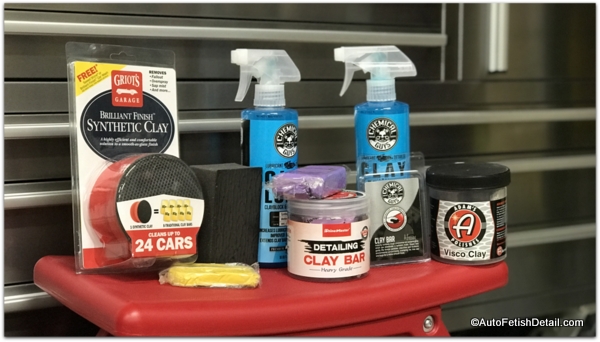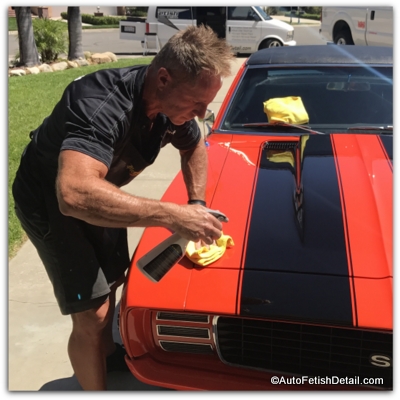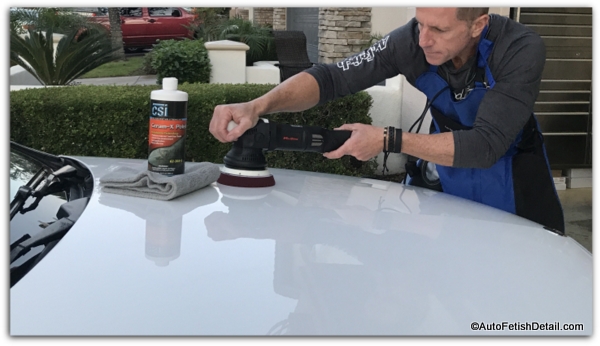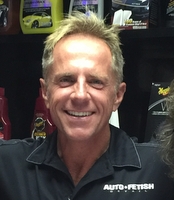Overspray on Car:
The amazing "tool" to answer your problem
Regardless s of whose car it is, overspray on car is not only a shocking discovery for any car owner, but once you stabilize from that initial shocker, then comes the follow-up questions.
Where did that paint overspray come from, when did it happen, where did it happen, and perhaps most importantly, how to remove overspray from a car...especially since it is probably your car with the overspray on it!
What is Overspray?
Simply put: overspray can be anything unwanted attached to the surface of your car that usually appears as little specs. These little specs can either be seen and/or felt. If you slide your hand across any part of your car and it feels like tiny particles of dirt are stuck to any surface of your car, chances are you have overspray on your car.
And chances are these tiny specs are a by-product of paint. Paint that was being sprayed near your car allowing the wet paint mist to float through the air and settle onto your car to dry.
These tiny paint particles are released into the air where the wind current blows them to land on anything they come in contact with. In this case this means your car paint. And not just your car paint, as paint overspray does not discriminate. It will attached to every surface of your car regardless of the material: paint, glass, rubber moldings, plastic trim, wheels, tires, etc., etc.
What if it is not paint overspray but something else?
Good question!
And in many ways it actually doesn't matter. What you do know for certain is that there are little (or bigger) specs attached to your car paint that you can both see and feel that you know doesn't belong there.
Paint should be smooth. If you feel a "texture" of any kind then you have some work to do. But overspray on car in the form of texture can actually be caused by more than just paint.
The world is a jungle and the air is filled with all kinds of unknown "air born pollutants" you don't want attaching to your cars paint or car windows:
- Overspray from paint (think of house painters, or commercial buidling painters using airless spray guns)
- Industrial fall-out (a glorified name for dirt particles floating around in the air that will attached to your cars surface and bond to the surface)
- Tree sap/tree pollen (Not all tree pollen and sap is created equal. Some is water soluable and comes in large drops, while other floats around as tinly particles that can also attach to your car)
- Exhaust emissions (the exhaust coming out your tail pipe also has very small particles inn it which can attach to your cars paint)
- brake dust (As you use yur brakes, the metal partciles are released into the air and can also setle onto your cars paint)
Overspray on Car:
Mostly bad news, but some good news added
The bad news is pretty obvious; you have some tiny specs of something attached to your car which deosn't feel right and will diminish the apearance of your car.
The good news is that the auto detailing industry has a cool tool that can handle most of the "unwanted" particles stuck to your car paint. And not only can this cool tool remove paint overspray from your cars paint, but also remove it from the majority of suraces on your entire car.
Overspray Clay Bar Remover
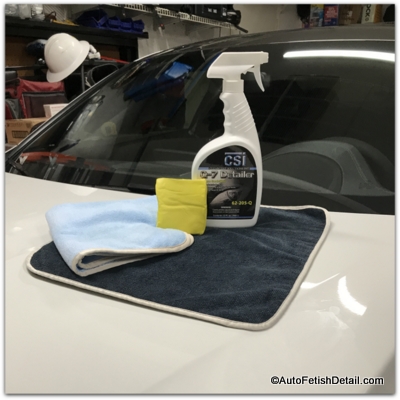
There is this really cool stuff generally called the clay bar. It is not just called the clay bar, as it goes by numerous names:
- Detailing clay
- Decontamination clay
- Surface preparation bar
- Clay bar
The goal of the clay bar is to remove what is generally called bonded surface contaminants. One of the more common contaminants is paint overspray on car. But since in the real world, we all have to deal with what is simply referred to as air pollution.
Everywhere in the world there are airborne pollutants floating around. We breathe these pollutants in, some settle onto to the ground, and some settle onto our cars. Not all airborn pollutants are the same. Some ariborn pollutants are worse than others and can literally stick to your cars surface materials and bond to the surface.
These pollutants bond so well, that normal washing and even waxing will not remove these bonded pollutants. But this is where the clay bar comes in. The clay bar was developed to remove these bonded pollutants that washing and waxing cannot.
How Does Overspray Clay Bar Work
Imagine a firm piece of Playdoh or molding clay. These clay bars are made with materials that have the ability to "grab" surface impurities (bonded contaminants) and shear them away.
This happens as you rub one of these clay bars across the surface, back and forth until the bonded contaminant is worn away. In the case of overspray on car, this means the clay bar will wear down, little by little as you rub the clay bar across your car paint until the paint overspray is gone.
What you are left over is silky smooth paint.or silky smooth car windows.
Mothers Clay Bar Kit:
Remove overspray and other surface contaminants
Mothers 07240 California Gold Clay Bar System
- Massively popular clay bar kit
- Everything you need to not only remove overspray on car, but decontaminate your entire car
- Comes with two clay bars
- Comes with clay lube needed to use the clay bars
Chemical Guys CLY_KIT_2 Medium Duty Clay Bar and Luber Synthetic Lubricant Kit (16 oz) (2 Items)
- Comes with a single, larger clay bar
- Comes with clay lube to use clay bar with
- Extremely popular clay bar kit
- Remove overspray on car while also removing other bonded surface contaminants
How to Use car Overspray Clay bar
Darren's Note: the clay bar as a rue is not referred to as overspray clay bar. It just seems to be labeled that by people looking to use the clay bar to remove paint overspray from their car.
To use the clay bar to effectively remove most forms of paint overspray on car along with any other bonded contaminants, follow these important recommendations:
- have your car washed first
- break down your car into manageable sections so you are not overwhelmed and you can keep track of your progress (working on each panel until complete is an easy solution)
- Spray surface with enough spray lubricant to allow the clay bar to glide back and forth as you rub it against the paint or glass surface
- Initially the clay bar will resist being able to glide across the surface due to the resistance of the surface contaminants or the overspay on car. As you rub and shear away the unwanted particles, the clay bar will begin to move more freely
- You will also hear a disturbing noise as the friction between the clay bar and the contaminants will create a disturbing noise until it breaks down and is removed. Just know that this is normal
- For very stubborn paint overspray removal, it is not uncommon to have to rub back and forth many times for complete removal (once again; paint overspray is not all created equally)
- The clay lube will not aid in removing any of the overspray on car or other bonded contaminants, so you simply only need to use enough to allow the clay bar to move back and forth across the surface of your car
- Because the clay bar is naturally tacky, it will prove in most cases, too difficult to use on textured black trim or rubber gasket pieces
- Despite what you may have heard in the past, if you happen to drop the clay bar onto the ground, you don't automatically have to throw it away and start with a new clay bar. Simply inspect and manually remove any obvious big particles from the ground and wash with water to help remove any finer particles from ground
- The more you use the clay bar, the more dirt will embed into the clay bar. Simply fold clay bar over as needed to reveal a cleaner section (I have had many clay bars literally last for years. the industry wants you to buy more of them so they will put the fear of God into you, thinking you must replace them more frequently than you really need to)" from the clay bar along your cars surfaces as you are using it. Weather conditions and the amount of lubricant will affect this. Don't worry about this. Once you are finished you can go back over your cars paint with some top rated car wax to now protect your car paint as normal, and you can remove any skid marks during the car waxing process. You can also use rubbing alcohol to easily and safely remove these skid marks.
- The clay bar is perfectly suited for any flat, hard surface: paint, glass, chrome, mirrors, hard, smooth black trim pieces, wheels, etc.
- he clay bar will put what is called micro-marring into your car paint. As a rule this is not a problem and once you wax your car, feel your car, and look at your car you will be more than happy! If you have a dark/black colored car and have to do excessive amounts of rubbing, you may want to polish your car next to remove this marring and restore some amazing gloss and depth to your car paint. This is very doable even if you are a beginner and want to polish your car before you wax it.
Overspray on Car:
additional tips from Darren
Not everything in life is created equally. This also holds true with overspray on cars. Not only is not all paint created equally, but the amount of paint overspray will be unique to your particular situation.
For this reason I want to lay out some additional tips in order to manage your expectations.
- The overspray on your car may come off very easily, or you may have to rub until your arm hurts
- Some paint overspray is industrial paint and simply will not be able to be removed with the overspray removal clay bar
- There are many nuances of your car that overspray will attached to. using the clay bar will prove completely unrealistic on these components. You will simply have to accept the limitations of removing overspray on car in certain areas of your car
I hope you are now informed and ready to use the clay bar to remove overspray from your car.
Sincerely,
Darren Priest
|
|
